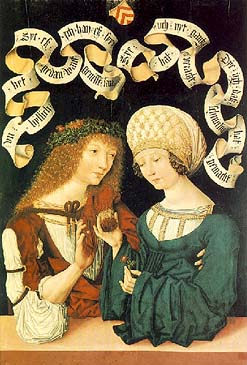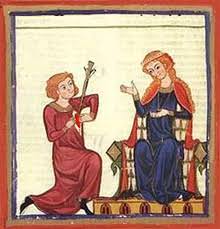The science of love in the Middle Ages, the romantic period, and our own time
Perry, Robert Graham
M.A. Thesis, The University of British Columbia, August, (1979)
Abstract
The discipline or category of the philosophy of love has been precisely defined, its diverse traditions fully documented and compared, and its distinctive rhetorical medium—the dialogue—analyzed in detail. Another of love’s disciplines, the science of love, has not fared as well: the nature of this discipline has seldom, if ever, been defined, few of its particular traditions have been documented, let alone compared, and its distinctive rhetorical medium—the love-treatise—has never been adequately analyzed. Two reasons for this neglect suggest themselves. First, love-science has often been perceived as being merely a frivolous, eccentric, reductive, or immoral discipline. It was in these terms that, for example, two of the finest nineteenth century contributions to the discipline, Goethe’s “Die Wahlverwandtschaften” and Stendhal’s “De l’Amour”, were critically received. Second, the discourse of love-science in general and of the love-treatise in particular has often been considered to be stylistically impure. What has been, and continues to be, neglected is a long-enduring and extremely rich tradition of colourfully hybrid texts. Both the necessity imposed by the length of this essay to take a limited focus on this tradition, and at the same time the desire to give an impression of its sweep and continuity, have been fulfilled by organizing the study in terms of a comparison between the love-sciences of two historical periods, the Middle Ages and the modern Romantic and post-Romantic Age. A number of fascinating connections suggest themselves. The Romantic descriptions of love’s chemical affinities and “cristallisations” profoundly resemble the grand medieval scientific erotic themes of the love potion and the malady of love. All four “topoi” fulfil an important dualistic function: they highlight “both the physical fatality of passion as -well as the possibility, explicit in the fact of the scientist’s control over nature, of limited control being exercised over that passion. Stendhal’s Romantic love-treatise “De l’Amour” bears a strong family resemblance to medieval love-treatises. The important theory of a comparative science of love which Stendhal articulates is prefigured in medieval culture, notably in the Arabic tradition of love-treatises. The form of the love-treatise provides the ideal medium for comparative studies of how love is perceived and experienced in different cultures and under different conditions. Both the Middle Ages and the Modern Age create scientific metaphors for love which possess great beauty. Two of the most beautiful of these are the medieval trope of the tree of love and Stendhal’s Romantic image of love’s “cristallisations”. The mock-science of love of a -writer like Andreas Capellanus provides a medieval antecedent to the mock erotic science created by Thomas Mann in his novel “Der Zauberberg”. Finally, in both the Middle Ages and the Modern period, the language of technology often plays a disturbing part in erotic analogies. Here, the science of love can become the revelation of a dehumanized conception of love. The science of love is not a true science. Neither is it a merely frivolous or inconsequential kind of literary discourse. The science of love consists of a whole complex of unverifiable, yet, nevertheless, extremely useful fictions about the nature of love. These fictions are useful because they explain the genesis, transformations, and conclusions of love. They are also useful because they express and celebrate the magic compulsion exercised by love. Finally, the fictions of love- science are useful because they have provided, in the form of the love-treatise, elaborate codifications of love. But the fictions of love-science hold a fascination beyond their provision of colourful and useful explanations or codifications of the notoriously indeterminate phenomenon of love; these fictions are compelling because they have shaped and continue to shape the erotic imagination and sensibility. The experience of love is far from innocent before the discourse of love.
The science of love in the Middle Ages, the romantic period, and our own time
Perry, Robert Graham
M.A. Thesis, The University of British Columbia, August, (1979)
Abstract
The discipline or category of the philosophy of love has been precisely defined, its diverse traditions fully documented and compared, and its distinctive rhetorical medium—the dialogue—analyzed in detail. Another of love’s disciplines, the science of love, has not fared as well: the nature of this discipline has seldom, if ever, been defined, few of its particular traditions have been documented, let alone compared, and its distinctive rhetorical medium—the love-treatise—has never been adequately analyzed. Two reasons for this neglect suggest themselves. First, love-science has often been perceived as being merely a frivolous, eccentric, reductive, or immoral discipline. It was in these terms that, for example, two of the finest nineteenth century contributions to the discipline, Goethe’s “Die Wahlverwandtschaften” and Stendhal’s “De l’Amour”, were critically received. Second, the discourse of love-science in general and of the love-treatise in particular has often been considered to be stylistically impure. What has been, and continues to be, neglected is a long-enduring and extremely rich tradition of colourfully hybrid texts. Both the necessity imposed by the length of this essay to take a limited focus on this tradition, and at the same time the desire to give an impression of its sweep and continuity, have been fulfilled by organizing the study in terms of a comparison between the love-sciences of two historical periods, the Middle Ages and the modern Romantic and post-Romantic Age. A number of fascinating connections suggest themselves. The Romantic descriptions of love’s chemical affinities and “cristallisations” profoundly resemble the grand medieval scientific erotic themes of the love potion and the malady of love. All four “topoi” fulfil an important dualistic function: they highlight “both the physical fatality of passion as -well as the possibility, explicit in the fact of the scientist’s control over nature, of limited control being exercised over that passion. Stendhal’s Romantic love-treatise “De l’Amour” bears a strong family resemblance to medieval love-treatises. The important theory of a comparative science of love which Stendhal articulates is prefigured in medieval culture, notably in the Arabic tradition of love-treatises. The form of the love-treatise provides the ideal medium for comparative studies of how love is perceived and experienced in different cultures and under different conditions. Both the Middle Ages and the Modern Age create scientific metaphors for love which possess great beauty. Two of the most beautiful of these are the medieval trope of the tree of love and Stendhal’s Romantic image of love’s “cristallisations”. The mock-science of love of a -writer like Andreas Capellanus provides a medieval antecedent to the mock erotic science created by Thomas Mann in his novel “Der Zauberberg”. Finally, in both the Middle Ages and the Modern period, the language of technology often plays a disturbing part in erotic analogies. Here, the science of love can become the revelation of a dehumanized conception of love. The science of love is not a true science. Neither is it a merely frivolous or inconsequential kind of literary discourse. The science of love consists of a whole complex of unverifiable, yet, nevertheless, extremely useful fictions about the nature of love. These fictions are useful because they explain the genesis, transformations, and conclusions of love. They are also useful because they express and celebrate the magic compulsion exercised by love. Finally, the fictions of love- science are useful because they have provided, in the form of the love-treatise, elaborate codifications of love. But the fictions of love-science hold a fascination beyond their provision of colourful and useful explanations or codifications of the notoriously indeterminate phenomenon of love; these fictions are compelling because they have shaped and continue to shape the erotic imagination and sensibility. The experience of love is far from innocent before the discourse of love.
a merely frivolous or inconsequential kind of literary discourse. The science of love consists of a whole complex of unverifiable, yet, nevertheless, extremely useful fictions about the nature of love. These fictions are useful because they explain the genesis, transformations, and conclusions of love. They are also useful because they express and celebrate the magic compulsion exercised by love. Finally, the fictions of love- science are useful because they have provided, in the form of the love-treatise, elaborate codifications of love. But the fictions of love-science hold a fascination beyond their provision of colourful and useful explanations or codifications of the notoriously indeterminate phenomenon of love; these fictions are compelling because they have shaped and continue to shape the erotic imagination and sensibility. The experience of love is far from innocent before the discourse of love.
Click here to read this article from The University of British Columbia
Subscribe to Medievalverse
Related Posts